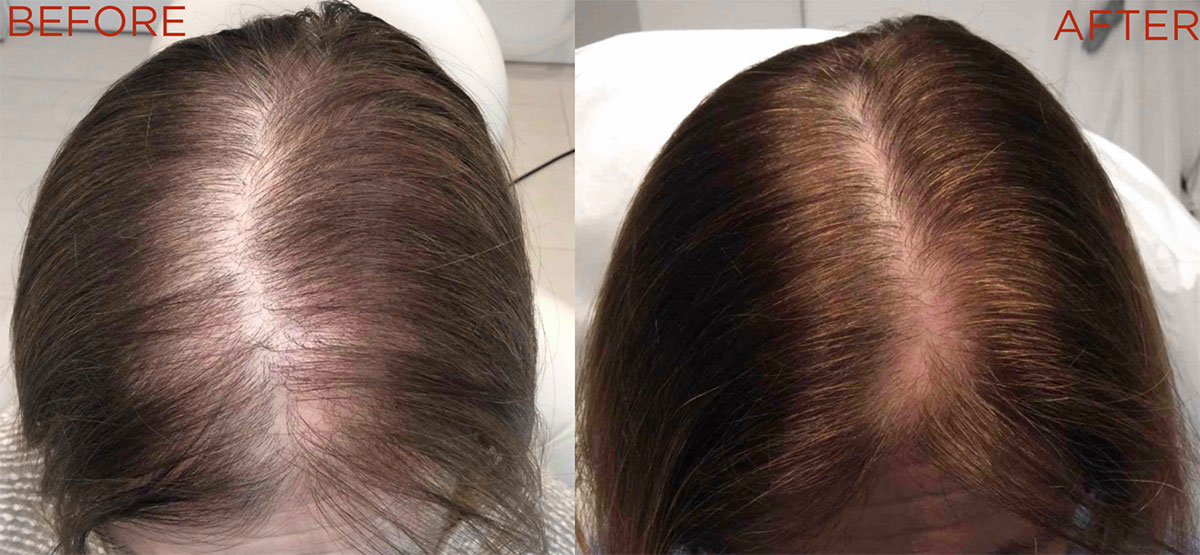Losing hair is a natural process since normally each person loses from 50 to 100 hairs a day. However, if you notice an unusual amount of hair strands on your brush or pillow, you might have alopecia. Androgenic alopecia is a hereditary disease causing baldness of a certain pattern.
Almost half of adult men and women face issues with hair growth. That’s why scientists are in search of effective treatments for hair loss. Platelet-Rich Plasma (PRP) is one of the promising ways to regrow hair and return self-confidence. In this article, we explain how PRP for hair loss works, its safety, and its results.
What is PRP therapy?
PRP therapy uses injections to deliver platelet-rich plasma to affected hair follicles. Platelets are cells we have in our blood alongside erythrocytes and leukocytes (red and white blood cells). Platelets play an essential role in the cell regeneration process by secreting growth factors. Platelet-rich plasma is made from a patient’s blood with the help of a centrifuge. Centrifuged plasma contains 5 times more platelets than blood.
PRP is widely used in regenerative medicine. Scientists managed to apply PRP for wound healing and cartilage, joints, and muscle restoration. Today PRP for hair loss is gaining popularity and lots of people are trying PRP injections for hair restoration and fighting hair loss. Several systematic reviews suggest PRP injections restore hair growth and help to combat alopecia.
PRP treatment for hair loss
PRP hair restoration is provided in 5 stages. Firstly, the doctor will take your blood samples to derive platelets. Blood is then centrifuged to gain platelet-rich plasma and platelet-poor plasma in one vial with a buffy coat, and then just platelet-rich plasma is separated for injection. Then a doctor injects PRP into hairless parts of your scalp. Your scalp may swell so you’ll need to wait until it’s recovered for a few hours and up to several days. The first visible results occur in 6 months after the therapy.
PRP is a progressive treatment as it uses our body components and no medications to boost the hair growth process. When platelets reach hair follicles, they stimulate cells responsible for hair growth. PRP therapy for hair health brings the following benefits:
- stimulates hair growth,
- prevents hair loss,
- improves hair quality,
- reduces dandruff and scalp dryness.

PRP for hair loss: treatment safety and results
PRP for hair loss is a safe procedure that doesn’t cause severe side effects. As PRP uses a patient’s tissue, there’s no risk of rejection or allergic reaction. PRP procedure involves several injections, so patients may experience skin swelling and/or bruises. Less common adverse effects include bleeding, infections, and skin damage. Since the PRP therapy for hair loss involves blood sampling, be sure to eat well, and drink enough water before the procedure to avoid feeling dizzy. Avoid taking alcohol or any harmful substances before the procedure since it badly influences the quality of your blood.
Androgenic alopecia is caused by increased testosterone and DHT hormones in the blood, and PRP treatment doesn’t regulate hormone levels. The therapy causes temporary effects that should be maintained by repeated treatment no more than once a year. Consider using PRP with hormone replacement therapy to achieve long-term results.
Wrapping up
Healthy hair is a part of youthfulness and attractiveness. Looking good helps us feel confident and beautiful. That’s why losing hair usually causes stress and low self-esteem. Luckily, medicine offers several treatment options for hair loss, and PRP is no exception.
PRP for hair loss is considered the safest way to restore hair as it uses biomaterial taken from a patient themselves, eliminating major side effects. PRP therapy for hair loss is a natural way to restore your hair strength and thickness. If you’re interested in PRP treatment for hair loss, contact us and our experts will guide you through the PRP hair restoration process.
Please get in touch with our team of experts to get a free consultation.

